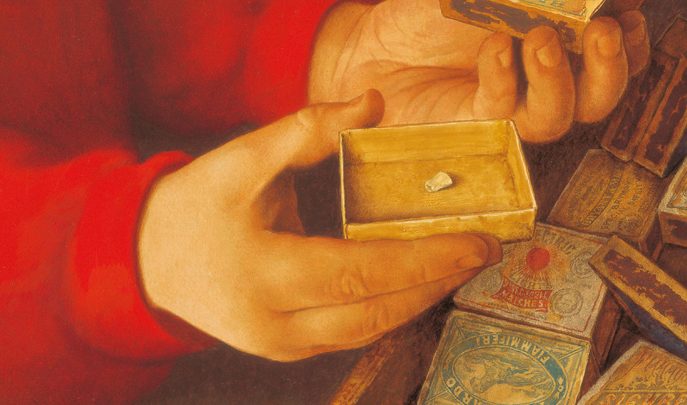KS2 Book Topic: Explore Migration And Personal Histories With The Matchbox Diaries

The Matchbox Diary shows how the simplest possessions can tell powerful stories about who we are and where we come from

- by Teachwire
- Classroom expertise and free resources for teachers

Picture books are miniature works of art, expertly imagined and imbued with multiple layers of meaning. The very best entice children, offer up meaningful encounters and then send them on their way, thoughts and memories enriched; they are more than the sum of their words and pictures.
The Matchbox Diary is such a book. Told entirely in dialogue, its luminous illustrations and pared-down text invite us to eavesdrop on a conversation between an old man and the great-granddaughter he’s never met before. “Pick whatever you like the most,” says the old man. “Then I’ll tell you its story.” The girl isn’t sure what to select, but the old man reassures her. She’ll know it when she spots it, he says, adding that her choice will help him understand her, too.
So the girl picks a battered cigar box. It’s full of matchboxes, each containing something tiny: an olive stone, a ticket stub, a bottle top. Collected by an illiterate child as a way of marking his experiences, the matchboxes create a record of a time long gone. And so begins the story of the old man’s life: of a childhood rooted in poverty, a long and frightening journey, and a new start in a place that has little to offer but hard work and anxiety.
The Matchbox Diary, however, is far from being a gloomy book. It’s also a story of family ties, of intellectual curiosity and openness. Every page is suffused with warmth – and a clear-sighted optimism that will be welcomed in these uncertain times. While children are enjoying its artwork and narrative energy, they’ll likely be unaware that it’s a powerful advocate for tolerance, empathy and compassion.
Sharing the book
Everyone will want to talk about The Matchbox Diary, but give it the time and space it needs to work its magic before holding a discussion. It’s best enjoyed as part of a shared, uninterrupted reading-for-pleasure experience, followed by plent If you do want to prepare your class before reading, you could make a diary-inspired matchbox and invite the children to explore it.
Making your own matchboxes
Creating an object-based diary using matchboxes will appeal to children and give you plenty of talking and writing opportunities. Use ‘reclaimed’ matchboxes, or decorate the plain white variety sold by craft outlets. Fleischman’s inspiration came from the map-covered diaries of artist Gary Hamel (paulfleischman.net/index.htm) – or you can use Ibatoulline’s illustrations as a starting point.
Why not make a collaborative diary of a class visit, or create a record of an entire school term? Alternatively, collect tiny objects of significance for individual diaries. Write about the process, creating instructions for others to follow and ‘object catalogues’ with illustrations.
Why we treasure objects
Talking about the way our lives live on through objects, Paul Fleischman recalls that, “My father kept his tailor-father’s heavy shears close by his desk.”
Many people have highly prized objects that don’t have a large monetary value. Talk about the items placed inside the boxes in this book. What events and memories do they represent?
Ask children to think about the objects they value, and to choose one. They should then describe it to a partner and invite questions. Why is it special? What does it do? Where do you keep it? How would you feel if you lost it?
Present the class with a dilemma: if they had to leave home and could only take one object, what would it be? Why did the boy in this story take an olive stone?
Collect tiny objects and explore them. What could they represent? Generate ideas before choosing an object and writing about it – both factually (what it looks and feels like) and fictionally (who it belonged to, why that person kept it).
Telling life stories
If an older visitor can tell your class a childhood story (or is prepared to share a migration memory) children can make audio recordings and transcribe them, rewrite stories in their own words or interview the visitor and compile a report. This may lead to stories emerging via children’s families, so be prepared to extend your project and collect into a class book.
In the The Matchbox Diary, every sepia drawing has its story and Ibatoulline provides lots of cues and clues. If you have older visitors in class, pair them with children and ask each pair to work together to invent and tell the story of their chosen picture.
Experimenting with dialogue
As well as writing picture books and novels, Fleischman writes poetry for several speakers (which he describes as ‘chamber music for voices’) and playscripts. So it’s not surprising to find him writing a text entirely in dialogue – but such a text is unusual in a picture book, and certainly worth exploring with your class.
What do your children think about the book’s dialogue? Use a traditionally constructed text (such as When Jessie Came Across the Sea by Amy Hest and P.J. Lynch) to help you work out what’s missing in the The Matchbox Diary.
What do the The Matchbox Diary’s illustrations provide that the text doesn’t? Would the book be as effective without its pictures? Talk about films, television dramas and plays that rely on visual storytelling as well as dialogue, and read the The Matchbox Diary’s dialogue aloud in pairs.
Collect old photographs showing people doing something, rather than posing for the camera. Interrogate by writing questions on sticky notes. Collate and discuss.
- Who could these people be?
- Why are they here?
- What are they thinking and feeling, and why?
- If you could step into the picture, what would you hear, smell and taste?
- Does anything surprise you?
- What happened before this photograph was taken? What will happen next?
What do these characters want? What’s stopping them achieving this? Choose your favourite photograph.
Using your responses, generate a mini-narrative and write it in traditional form, like the Jessie text. Once you’ve edited your narratives, rewrite them as dialogues, like the The Matchbox Diary text.
In pairs, perform your dialogues – perhaps against a backdrop of your photograph, enlarged.
Painting reality
Ibatoulline’s finely detailed and expressive illustrations were painted using acrylic gouache. Framed sepia vignettes depict the boy’s memories, while the modern scenes are painted without borders in warmer shades of brown and amber.
Read this quote from The Wall Street Journal: “Ibatoulline can create images so exquisitely realistic… they could be mistaken for photographs”
Is this true? What tells you the The Matchbox Diary’s illustrations aren’t photographs? Is it good for art to be mistaken for real life? What can art do that photos can’t?
Look at the work of ‘realistic’ illustrators (Kim Lewis, Christian Birmingham…) and compare with those using different approaches (Oliver Jeffers, Mini Grey…)
Draw an object from life, making it as ‘real’ as possible. Inspired by the less-realistic illustrations you’ve seen, draw the same object using a variety of techniques and media. Thinking about art and realism, what’s the effect of each approach? Remember – there are no right answers and you don’t have to be an expert to take part. By observing, reflecting, questioning and researching, children develop their aesthetic awareness and are better able to form and express opinions.
Playing with print
Fleischman’s family owned a hand printing press, and typesetting was a familiar task. In The Matchbox Diary, the old man’s childhood illiteracy and subsequent life choices form part of what Fleischman refers to as a “hymn to literacy” throughout the book.
Use the illustration of the typesetting workshop to play ‘step into the picture’. Interrogate it for everything it can tell you about setting, characters and possible events. Use your observations to kickstart research into the history of printing. Set some type using an old-fashioned printing kit, and print a handbill for a school event or similar. Explore computer fonts, using them to print your favourite poems. Collect font names, and create a sound-poem that plays with them.
Migration stories
Research early migration to America. What does the The Matchbox Diary tell us about the lives and experiences of such migrants?
Find out about migration today. Carefully selected newspaper reports alongside fictional resources will help generate a balanced, informed and age-appropriate discussion. Try The Week Junior for factual reporting.
Fictionalised accounts can be found in all of the following: Azzi in Between by Sarah Garland; The Silence Seeker by Ben Morley; Give Me Shelter edited by Tony Bradman; and The Unforgotten Coat by Frank Cottrell Boyce.
If you liked this, try…
- Grandpa Green, by Lane Smith
- The Arrival, by Shaun Tan
- When Jessie Came Across the Sea, by Amy Hest and P.J. Lynch
- The Christmas Miracle of Jonathan Toomey, by Susan Wojciechowski and P.J. Lynch
- Weslandia, by Paul Fleischman and Kevin Hawkes
Mini theatres
Fleischman makes tiny working matchbox ‘theatres’ using cranks and other engineering to animate his scenes. Watch the online video for inspiration and instructions:
Carey Fluker Hunt is a freelance writer, children’s book ambassador and creative consultant.










